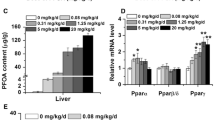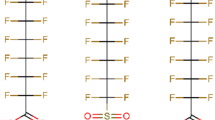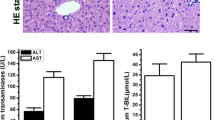Abstract
Ammonium perfluorooctanoate (APFO), a processing aid used in the production of fluoropolymers, produces hepatomegaly and hepatocellular hypertrophy in rodents. In mice, APFO-induced hepatomegaly is associated with increased activation of the xenosensor nuclear receptors, PPARα and CAR/PXR. Although non-genotoxic, chronic dietary treatment of Sprague–Dawley (S–D) rats with APFO produced an increase in benign tumours of the liver, acinar pancreas, and testicular Leydig cells. Most of the criteria for establishing a PPARα-mediated mode of action for the observed hepatocellular tumours have been previously established with the exception of the demonstration of increased hepatocellular proliferation. The present study evaluates the potential roles for APFO-induced activation of PPARα and CAR/PXR with respect to liver tumour production in the S-D rat and when compared to the specific PPARα agonist, 4-chloro-6-(2,3-xylidino)-2-pyrimidinylthioacetic acid (Wy 14,643). Male S-D rats were fed APFO (300 ppm in diet) or Wy 14,643 (50 ppm in diet) for either 1, 7, or 28 days. Effects of treatment with APFO included: decreased body weight; hepatomegaly, hepatocellular hypertrophy, hepatocellular hyperplasia (microscopically and by BrdU labelling index), and hepatocellular glycogen loss; increased activation of PPARα (peroxisomal β-oxidation and microsomal CYP4A1 protein); decreased plasma triglycerides, cholesterol, and glucose; increased activation of CAR (CYP2B1/2 protein) and CAR/PXR (CYP3A1 protein). Responses to treatment with Wy 14,643 were consistent with increased activation of PPARα, specifically: increased CYP4A1 and peroxisomal β-oxidation; increased hepatocellular hypertrophy and cell proliferation; decreased apoptosis; and hypolipidaemia. With the exception of decreased apoptosis, the effects observed with Wy 14,643 were noted with APFO, and APFO was less potent. These data clearly demonstrate an early hepatocellular proliferative response to APFO treatment and suggest that the hepatomegaly and tumours observed after chronic dietary exposure of S-D rats to APFO likely are due to a proliferative response to combined activation of PPARα and CAR/PXR. This mode of action is unlikely to pose a human hepatocarcinogenic hazard.

Similar content being viewed by others
References
Bentley P, Calder I, Elcombe C, Grasso P, Stringer D, Wiegand H-J (1993) Hepatic peroxisome proliferation in rodents and its significance for humans. Food Chem Toxicol 31:857–907
Berthiaume J, Wallace KB (2002) Perfluorooctanoate, perflourooctanesulfonate, and N-ethyl perfluorooctanesulfonamido ethanol; peroxisome proliferation and mitochondrial biogenesis. Toxicol Lett 129:23–32
Biegel LB, Hurtt ME, Frame SR, O’Connor JC, Cook JC (2001) Mechanisms of extrahepatic tumor induction by peroxisome proliferators in male CD rats. Toxicol Sci 60:44–55
Bjork JA, Wallace KB (2009) Structure-activity relationships and human relevance for perfluoroalkyl acid-induced transcriptional activation of peroxisome proliferation in liver cell cultures. Toxicol Sci 111:89–99
Bronfmann M, Inestrosa NC, Leighton F (1979) Fatty acid oxidation by human liver peroxisomes. Biochem Biophys Res Commun 88:1030–1036
Burton K (1956) A study of the conditions and mechanism of the diphenylamine reaction for the colorimetric estimation of deoxyribonucleic acid. Biochem J 62:315–323
Butenhoff J, Costa G, Elcombe C, Farrar D, Hansen K, Iwai H, Jung R, Kennedy G Jr, Lieder P, Olsen G, Thomford P (2002) Toxicity of ammonium perfluorooctanoate in male cynomolgus monkeys after oral dosing for 6 months. Toxicol Sci 69:244–257
Cheung C, Akiyama TE, Ward JM, Nicol CJ, Feigenbaum L, Vinson C, Gonzalez FJ (2004) Diminished hepatocellular proliferation in mice humanized for the nuclear receptor peroxisome proliferator-activated receptor alpha. Cancer Res 64:3849–3854
Doull J, Cattley R, Elcombe C, Lake BG, Swenberg J, Wilkinson C, Williams G, van Gemert M (1999) A cancer risk assessment of di(2-ethylhexyl)phthalate: application of the new U.S. EPA risk assessment guidelines. Regul Toxicol Pharmacol 29:327–357
Gonzalez FJ, Shah YM (2008) PPARalpha: mechanism of species differences and hepatocarcinogenesis of peroxisome proliferators. Toxicology 246:2–8
Hirose Y, Nagahori N, Yamada T, Deguchi Y, Tomigahara Y, Nishioka K, Uwagawa S, Kawamura S, Isobe N, Lake BG, Okuno Y (2009) Comparison of the effects of the synthetic pyrethroid Metofluthrin and phenobarbital on CYP2B form induction and replicative DNA synthesis in cultured rat and human hepatocytes. Toxicology 258:64–69
Huang W, Zhang J, Washington M, Liu J, Parant JM, Lozano G, Moore DD (2005) Xenobiotic stress induces hepatomegaly and liver tumors via the nuclear receptor constitutive androstane receptor. Mol Endocrinol 19:1646–1653
International Agency for Research on Cancer (IARC) (2001) IARC monographs on the evaluation of carcinogenic risks to humans. Some thyrotropic agents. Vol. 79. IARC Press, Lyon
Kennedy GL Jr, Butenhoff JL, Olsen GW, O’Connor JC, Seacat AM, Perkins RG, Biegel LB, Murphy SR, Farrar DG (2004) The toxicology of perfluorooctanoate. Crit Rev Toxicol 34:351–384
Klaunig JE, Babich MA, Baetcke KP, Cook JC, Corton JC, David RM, DeLuca JG, Lai DY, McKee RH, Peters JM, Roberts RA, Fenner-Crisp PA (2003) PPARalpha agonist-induced rodent tumors: modes of action and human relevance. Crit Rev Toxicol 33:655–780
Lake BG (2009) Species differences in the hepatic effects of inducers of CYP2B and CYP4A subfamily forms: relationship to rodent liver tumour formation. Xenobiotica 39:582–596
Lau C, Anitole K, Hodes C, Lai D, Pfahles-Hutchens A, Seed J (2007) Perfluoroalkyl acids: a review of monitoring and toxicological findings. Toxicol Sci 99:366–394
Lee SS, Pineau T, Drago J, Lee EJ, Owens JW, Kroetz DL, Fernandez-Salguero PM, Westphal H, Gonzalez FJ (1995) Targeted disruption of the alpha isoform of the peroxisome proliferator-activated receptor gene in mice results in abolishment of the pleiotropic effects of peroxisome proliferators. Mol Cell Biol 15:3012–3022
Leonard RC, Kreckmann KH, Sakr CJ, Symons JM (2008) Retrospective cohort mortality study of workers in a polymer production plant including a reference population of regional workers. Ann Epidemiol 18:15–22
Lowry OH, Rosebrough NJ, Farr AL, Randall RJ (1951) Protein measurement with the folin phenol reagent. J Biol Chem 193:265–275
Lundin JI, Alexander BH, Olsen GW, Church TR (2009) Ammonium perfluorooctanoate production and occupational mortality. Epidemiology 20:921–928
Maloney EK, Waxman DJ (1999) Trans-Activation of PPARalpha and PPARgamma by structurally diverse environmental chemicals. Toxicol Appl Pharmacol 161:209–218
Morimura K, Cheung C, Ward J, Reddy JK, Gonzalez FJ (2006) Differential susceptibility of mice humanized for peroxisome proliferator-activated receptor a to Wy-14, 643-induced liver tumorigenesis. Carcinogenesis 27:1074–1080
Nakamura T, Ito Y, Yanagiba Y, Ramdhan DH, Kono Y, Naito H, Hayashi Y, Li Y, Aoyama T, Gonzalez FJ, Nakajima T (2009) Microgram-order ammonium perfluorooctanoate may activate mouse peroxisome proliferator-activated receptor α, but not human PPARα. Toxicology 265:27–33
Olsen JH, Boice JD Jr, Jensen JPA, Fraumeni JF Jr (1989) Cancer among epileptic patients exposed to anticonvulsant drugs. J Natl Cancer Inst 81:803–808
Olsen JH, Schulgen G, Boice JD Jr, Whysner J, Travis LB, Williams GM, Johnson FB, McGee JO (1995) Antiepileptic treatment and risk for hepatobiliary cancer and malignant lymphoma. Cancer Res 55:294–297
Parzefall W, Erber E, Sedivy R, Schulte-Hermann R (1991) Testing for induction of DNA synthesis in human hepatocyte primary cultures by rat liver tumor promoters. Cancer Res 51:1143–1147
Pastoor TP, Lee KP, Perri MA, Gillies PJ (1987) Biochemical and morphological studies of ammonium perfluorooctanoate-induced hepatomegaly and peroxisome proliferation. Exp Molec Path 47:98–109
Pirttiaho HI, Sotaniemi EA, Ahokas JT, Pitkänen U (1978) Liver size and indices of drug metabolism in epileptics. Br J Clin Pharmacol 6:273–278
Pirttiaho HI, Sotaniemi EA, Pelkonen RO, Pitkänen U (1982) Hepatic blood flow and drug metabolism in patients on enzyme-inducing anticonvulsants. Eur J Clin Pharmacol 22:441–445
Rosen MB, Lee JS, Ren H, Vallanat B, Liu J, Waalkes MP, Abbott BD, Lau C, Corton JC (2008a) Toxicogenomic dissection of the perfluorooctanoic acid transcript profile in mouse liver: evidence for the involvement of nuclear receptors PPAR alpha and CAR. Toxicol Sci 103:46–56
Rosen MB, Abbott BD, Wolf DC, Corton JC, Wood CR, Schmid JE, Das KP, Zehr RD, Blair ET, Lau C (2008b) Gene profiling in the livers of wild-type and PPAR{alpha}-null mice exposed to perfluorooctanoic acid (PFOA). Toxicol Pathol 36:592–607
Ross J, Plummer SM, Rode A, Scheer N, Bower CC, Vogel O, Henderson CJ, Wolf CR, Elcombe CR (2010) Human constitutive androstane receptor (CAR) and pregnane X receptor (PXR) support the hypertrophic but not the hyperplastic response to the murine non-genotoxic hepatocarcinogens phenobarbital and chlordane in vivo. Toxicol Sci. doi:10.1093/toxsci/kfq118
Scheer N, Ross J, Rode A, Zevnik B, Niehaves S, Faust N, Wolf CR (2008) A novel panel of mouse models to evaluate the role of human pregnane X receptor and constitutive androstane receptor in drug response. J Clin Invest 118:3228–3239
Shah YM, Morimura K, Yang Q, Tanabe T, Takagi M, Gonzalez FJ (2007) Peroxisome proliferator-activated receptor alpha regulates a microRNA-mediated signaling cascade responsible for hepatocellular proliferation. Mol Cell Biol 27:4238–4247
Sibinski LJ, Allen JL, Erickson EE (1983) Two year oral (diet) toxicity/carcinogenicity study of fluorochemical FC-143 in rats. Expt. No. 0281CR0012. Available on USEPA Docket AR226–0437-0440. Riker Laboratories, Inc., St. Paul
Takacs ML, Abbott BD (2007) Activation of mouse and human peroxisome proliferator-activated receptors (alpha, beta/delta, gamma) by perfluorooctanoic acid and perfluorooctane sulfonate. Toxicol Sci 95:108–117
Vanden Heuvel JP, Thompson JT, Frame SR, Gillies PJ (2006) Differential activation of nuclear receptors by perfluorinated fatty acid analogs and natural fatty acids: a comparison of human, mouse, and rat peroxisome proliferator-activated receptor-α, -β, and -γ, liver X receptor-β, and retinoid X receptor-α. Toxicol Sci 92:476–489
Walters MW, Bjork JA, Wallace KB (2009) Perfluorooctanoic acid stimulated mitochondrial biogenesis and gene transcription in rats. Toxicology 264:10–15
Wei P, Zhang J, Egan-Hafley M, Liang S, Moore DD (2000) The nuclear receptor CAR mediates specific xenobiotic induction of drug metabolism. Nature 407:920–923
Whysner J, Ross PM, Williams GM (1996) Phenobarbital mechanistic data and risk assessment: enzyme induction, enhanced cell proliferation, and tumor promotion. Pharm Ther 71:153–191
Wolf CJ, Takacs ML, Schmid JE, Lau C, Abbott BD (2008) Activation of mouse and human peroxisome proliferator-activated receptor alpha (PPARα) by perfluoroalkyl acids (PFAAs) of different functional groups and chain lengths. Toxicol Sci 106:162–171
Yamamoto Y, Moore R, Goldsworthy TL, Negishi M, Maronpot RR (2004) The orphan nuclear receptor constitutive active/androstane receptor is essential for liver tumor promotion by phenobarbital in mice. Cancer Res 64:7197–7200
Acknowledgments
This work was supported by Plastics Europe. We wish to thank Robert Powrie (CXR Biosciences) for the analyses of plasma PFOA concentrations.
Conflict of interest statement
With the exception of JRF, all authors represent organizations that have a current or former financial interest in ammonium perfluorooctanoate.
Author information
Authors and Affiliations
Corresponding author
Rights and permissions
About this article
Cite this article
Elcombe, C.R., Elcombe, B.M., Foster, J.R. et al. Hepatocellular hypertrophy and cell proliferation in Sprague–Dawley rats following dietary exposure to ammonium perfluorooctanoate occurs through increased activation of the xenosensor nuclear receptors PPARα and CAR/PXR. Arch Toxicol 84, 787–798 (2010). https://doi.org/10.1007/s00204-010-0572-2
Received:
Accepted:
Published:
Issue Date:
DOI: https://doi.org/10.1007/s00204-010-0572-2




